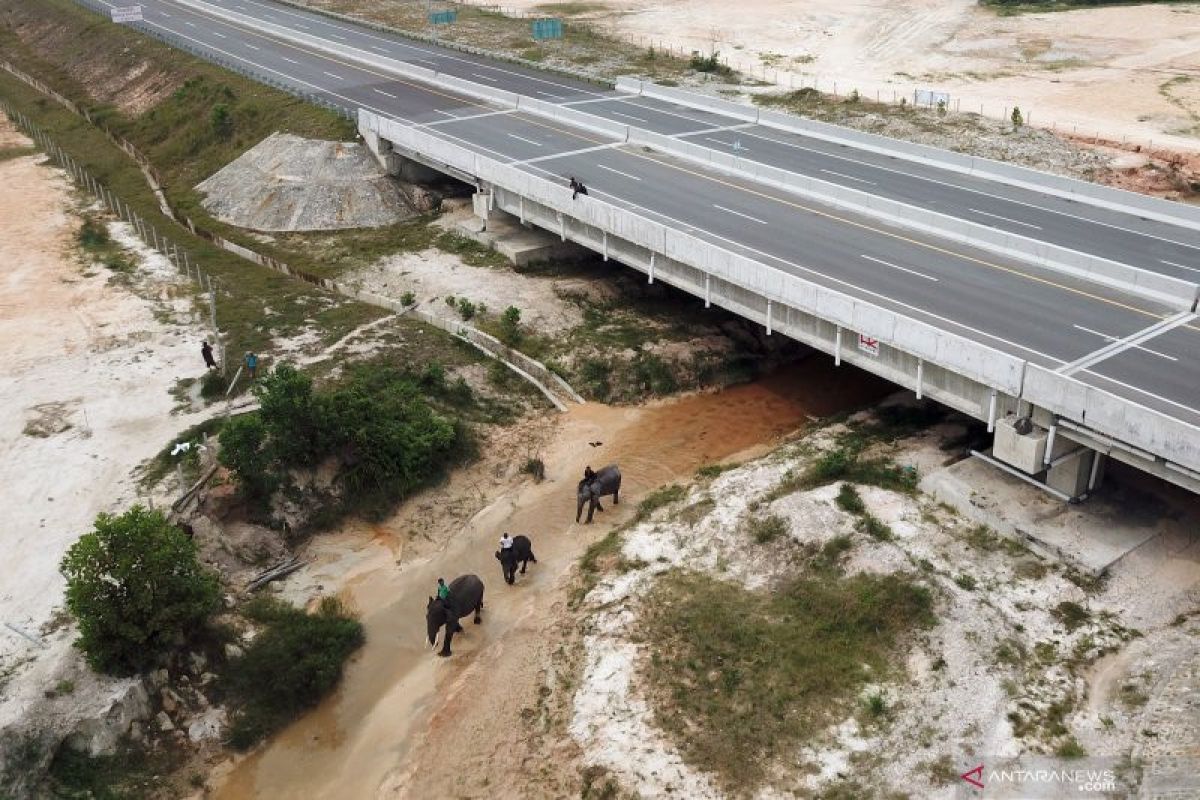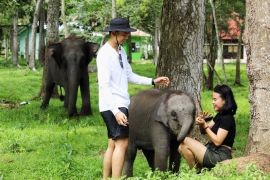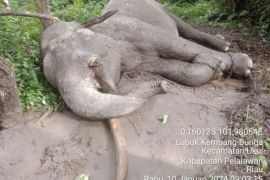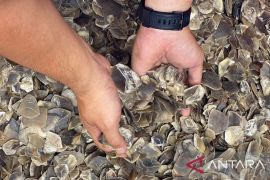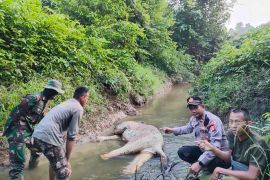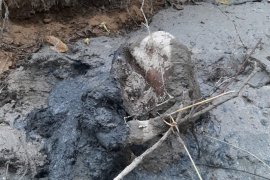There is a small brook on the tunnel, and if the brook is flooded, then Codet cannot pass through itPekanbaru, Riau (ANTARA) - In the morning of Valentine's Day in 2022, an elephant, called Codet, crossed the Pekanbaru-Dumai toll road at the 73rd-kilometre point of the highway.
Codet, the male elephant, made his way from the Giam Siak Kecil region to the Balai Raja region to seek a female elephant, as it was mating season.
Codet breached the toll road fence to cross the toll road and reach the Balai Raja Natural Reserve located just a few kilometers away from the toll road.
The male Sumatran elephant (Elephas maximum sumatrensis) braved the road traffic to reach the other side of the natural reserve due to flooding that inundated the tunnel below the toll road, specifically built for Codet and the other elephants to cross the toll road.
Perhaps, this is the first time Codet observed that the tunnel he usually used to cross the road could be inundated with rainwater.
The 44-year-old elephant’s action to cross the road was recorded by the toll road CCTV that then turned viral and made him an instant celebrity, as social media users widely circulated the recording.
Related news: Wild elephants go on rampage in Aceh destroying villagers' harvest
The video showed that Codet was able to cross a near-empty toll road that allowed passing cars to slow down and enabled him to cross the road.
Drawing attention to the male elephant’s action, Riau Natural Resources Conservation Agency’s (BBKSDA's) technical department head, M. Mahfud, stated that the protected male elephant is a native of the Balai Raja natural reserves and lives in an elephant reserve in the park.
Codet is known to be a solitary elephant that prefers to be alone and has no friends, he stated.
“He wants to go to the Giam Siak Kecil region to seek a friend or a female for mating,” Mahfud remarked.
Mahfud revealed that the elephant was named Codet developed a scar on his body after a fight with another elephant in 2017. The scar that formed on his body is locally known as “codet” due to which he got that name.
The department head said that the GPS collar attached to Codet’s neck revealed that the elephant frequented Giam Siak Kecil and stayed there for three months before returning to Balai Raja and then back to Giam Siak Kecil as the cycle repeated.
Related news: More clusters of Sumatran elephant rehab centers required: Walhi
He confirmed that flooding in the elephant tunnel constructed below the toll road drove Codet to cross the toll road.
“There is a small brook on the tunnel, and if the brook is flooded, then Codet cannot pass through it,” Mahfud stated.
Codet became the first elephant to cross the toll road -- instead of the tunnel -- after the toll road was inaugurated by President Joko Widodo in September last year, he stated.
Ensuring the safety of elephants and drivers
To prevent Codet and other elephants from crossing the toll road again, the natural conservation agency and toll road operator PT Hutama Karya conceived several measures.
The Pekanbaru-Dumai toll road, which reduces the travel time between the two major cities in Riau Province, also divides the animal habitat that has existed since long in the region. Stakeholders should ensure that the activities of animals living in the reserve would not be hindered by the toll road.
Related news: Several houses in Aceh ravaged as wild elephants run amok
The toll road operator confirmed that they would set up rubber strips to slow down traffic and caution drivers along the elephant crossing area, spanning from kilometer 64 to kilometer 69 of the toll road, as well as erect a safety metal fence along two sides of the toll road.
Branch Manager of PT Hutama Karya’s Pekanbaru-Dumai toll road branch, A. A. G. Indrajana, reported that the company had procured GPS collars to help track locations and movements of elephants at the natural reserve. The GPS collars have also been affixed on several elephants.
Toll road operator staff will receive training on handling elephants that cross the toll road, and information about elephant activities would also be offered to drivers, he noted.
Indrajana emphasized that the safety of drivers at the toll road and elephants at the natural reserve was paramount, so measures taken aim to ensure harmonious existence of elephants along the toll road that runs through their habitat.
The authority estimates that at least 55 elephants live at the Balai Raja and Giam Siak Kecil natural reserves. As the toll road contractor received the information during the development of the toll road, they decided to construct five 45-metre tunnels below the toll road to enable elephants to conveniently cross the tunnel at any time.
Evaluating the recent flood situation in the tunnel, which drove Codet to cross the toll road, the company has also constructed infiltration wells to prevent flooding from recurring in future.
Orange and banana trees, among others, disliked by elephants would also be planted along the toll road to deter Codet and others of his species from venturing too close to the toll road again.
Related news: Human-elephant conflicts spike in Riau following forest fires
The Pekanbaru-Dumai toll road might be one of the only several toll roads in the world that runs through natural reserves where animals endemic to the forests, including elephants, are found, and scenic views of such species could be witnessed by drivers to escape boredom after monotonously driving along the toll road for hours.
While drivers could enjoy the scenic view, the safety of Codet and other elephants must also be ensured. Preventive measures must be undertaken to ensure that elephants can co-exist harmoniously with human-made structures that run through their habitat and to ensure that drivers can ride safely on the toll road without fear of wild animals inadvertently disrupting their journey.
Related news: Papua: MP seeks sanctions against separatists for shooting PTT workers
Related news: Several new COVID-19 transmission clusters found in Surabaya
Editor: Fardah Assegaf
Copyright © ANTARA 2022
